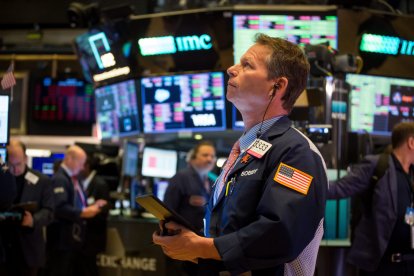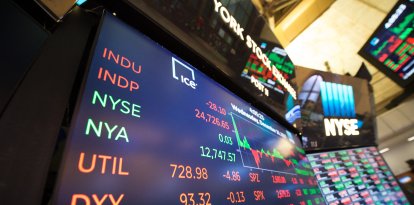Fears of US recession and China's slowdown lead Wall Street to its worst week since the banking crisis of 2023
The August unemployment data for the world's leading power and the macroeconomic indicators published this week for both countries have led to declines in the world's major stock markets over the past few days.

A trader at the New York Stock Exchange.
The eagerly awaited US unemployment data, published last Friday, has not served to calm investors' fears, but to confirm that what is actually threatened is the world's leading economy. As if that were not enough, the country's unflattering macroeconomic data have been joined by figures from China that are well below expectations and which warn that things are not going well in the Asian giant.
The publication by the Department of Labor of the employment data for August did not trigger a catastrophe as it did last month with those for July. However, and despite the effort to sell them as an improvement, the reality is that they are still notably below expectations.The 142,000 new jobs are far from the 165,000 expected, and the reduction of just one-tenth of a percent in the unemployment rate (4.2% compared to 4.3% in the previous month) is not exactly a figure to celebrate.
The number of unemployed is still above 7 million
Especially because if you take into account the number of people who have stopped looking for work and those working part-time who would like a full-time job but economic circumstances do not allow it, the rate soars to 7.9%, the highest since 2021. The number of people out of work remains above 7 million, despite a slight improvement in August.
However, there is one area of major concern for investors: downward corrections. The latest report revised the June and July data, significantly reducing the new jobs created in those months. Thus, in July 89,000 jobs were created versus the 114,000 announced. Even worse is what happened in June, which actually created 118,000 jobs, compared to the 179,000 published... which had already been corrected from the 206,000 initially reported.
S&P 500 closes its worst week of the year
This has not gone unnoticed, and the international stock markets have experienced a week of turbulence and significant falls from which Wall Street has not emerged unscathed. The S&P 500 and the Nasdaq are the two indexes with the worst data in the US -the Dow Jones is not doing much better either-, with weekly declines not seen since the banking crisis last year that threatened to sweep the global economy.
Although the closes have not come close to reflecting the worst moments of each day, the markets have given up a significant portion of their value this week. Deserving special mention are Nvidia, which lost more than $280 billion or US Steel following the Biden-Harris Administration's moves toward vetoing its purchase by Nippon Steel.
Indicators point to a cooling in the US and China
The S&P 500 led the week's declines. The loss of 1.73 points with which it closed on Friday make a weekly accumulated -4.25%, figures not seen since March 2023. The Nasdaq closed Friday with declines of 2.69%, dragged down by Broadcom (-10.36%) and Tesla (-8.45), despite Nvidia slightly wiping out its black week. In the last 4 days (domestic markets were not open on Monday due to Labor Day) the technology index lost 5.89%. The Dow Jones, meanwhile, finally gave up only 1.01% on Friday, giving a weekly decline of 2.93%.
The cooling of the national labor market adds to other indicators released this week on industrial activity that send a message, at the very least worrisome, if not alarming, about the possibility of the world's leading economy entering recession. Data published by China also show that the Asian giant's economy is slowing down and, according to JP Morgan, will end the year with a growth of 4.6%, compared to the 5% target set by Beijing. These four tenths, in a market as large as China's, represent a big difference that has ended up staining the international stock markets red.
The Fed is closer to a 0.5% rate cut after the August employment data
RECOMMENDATION





















